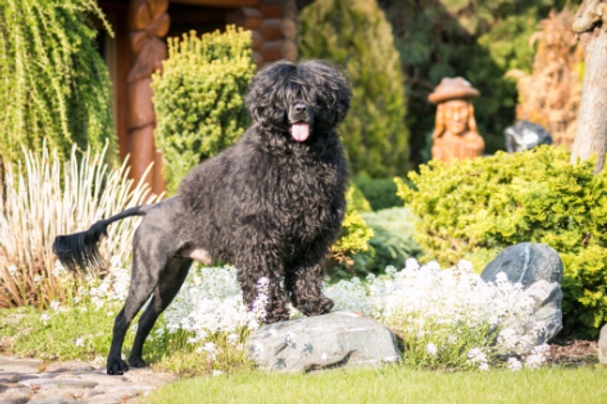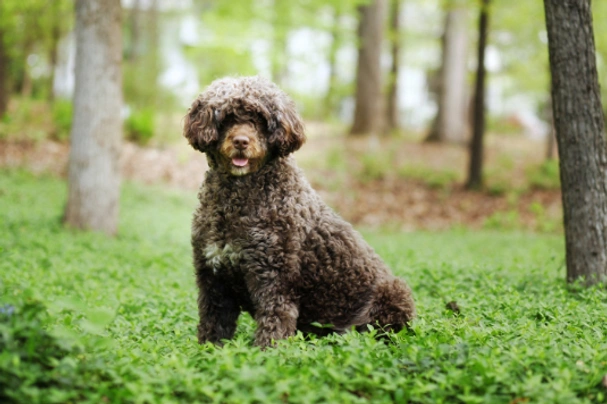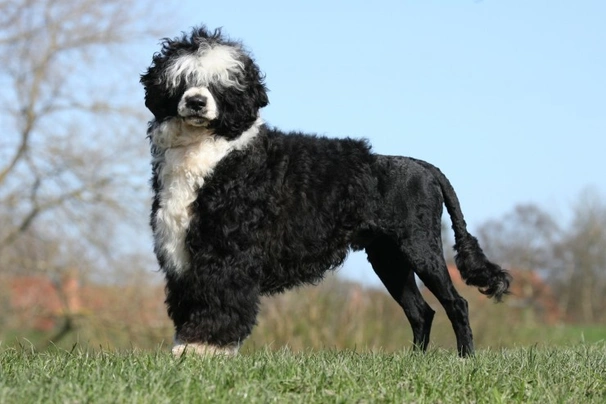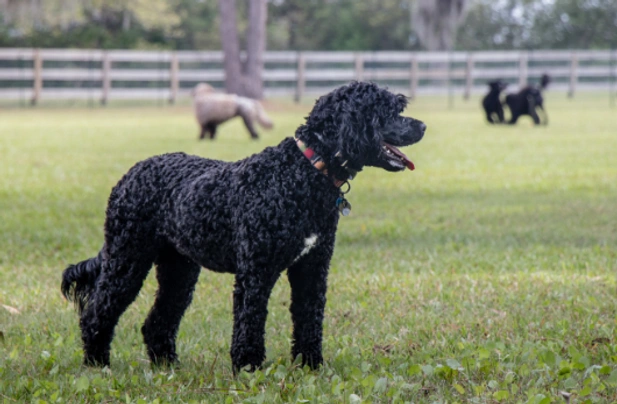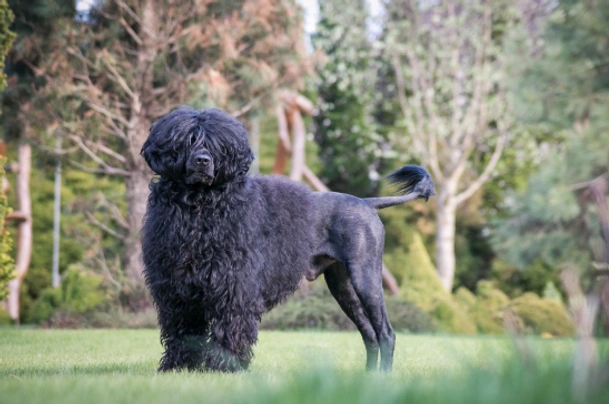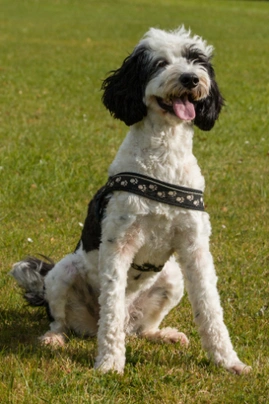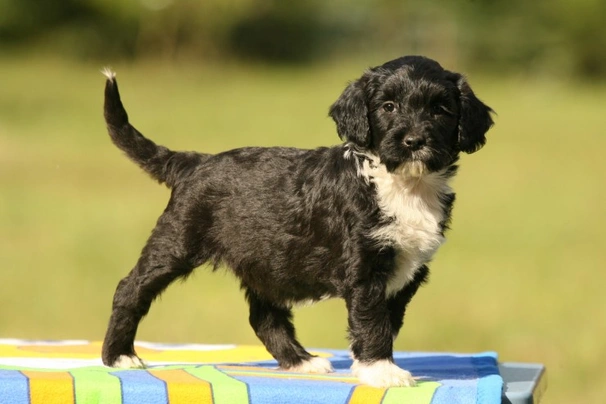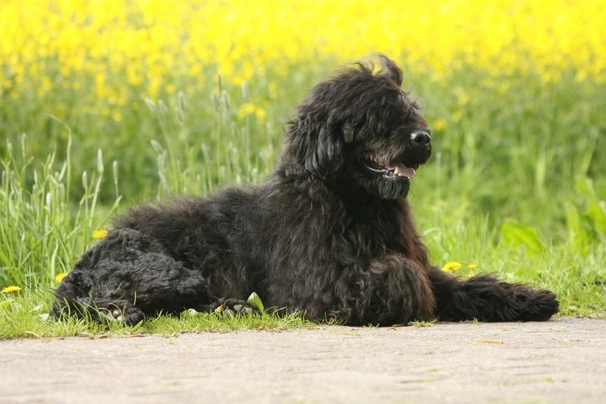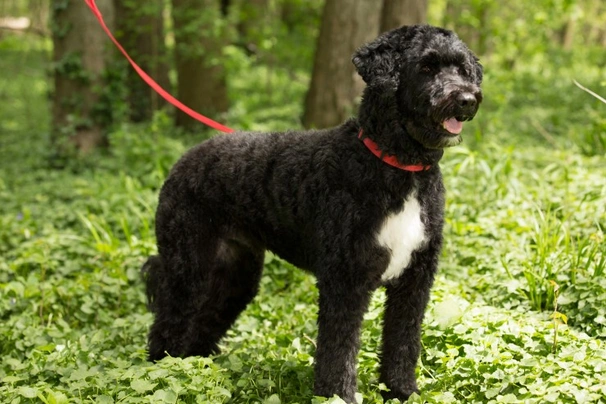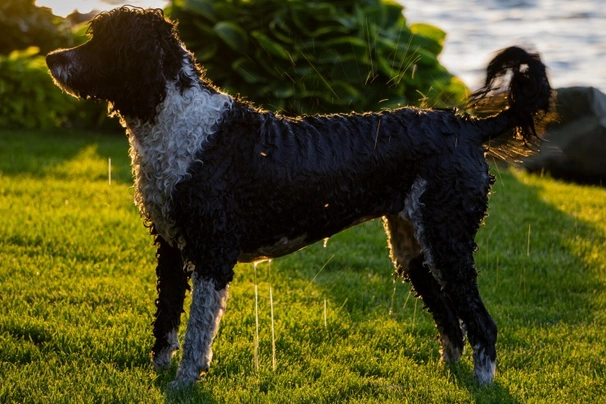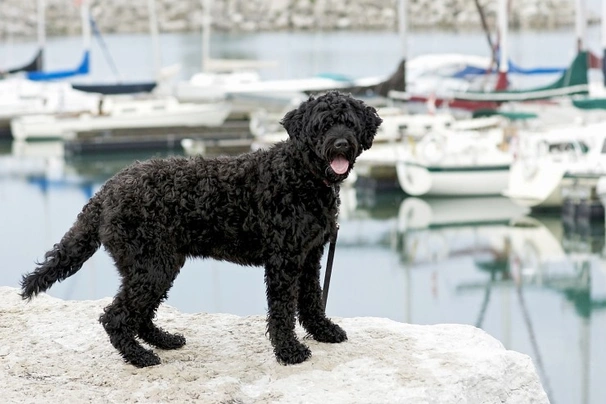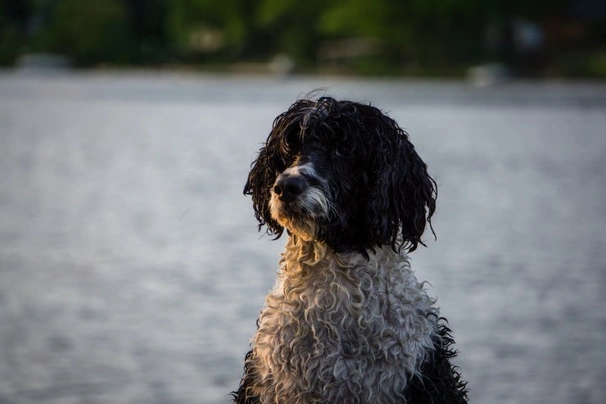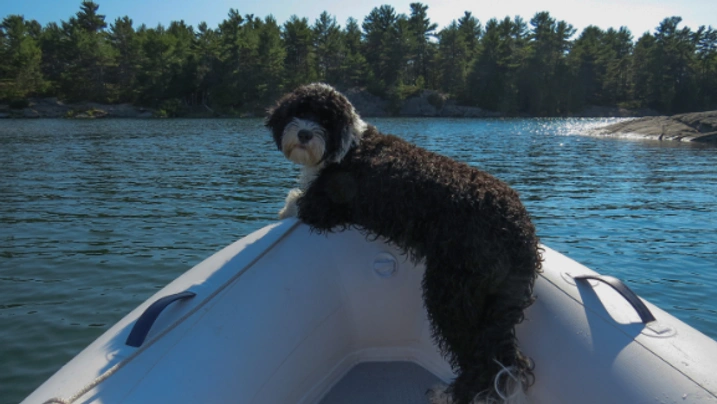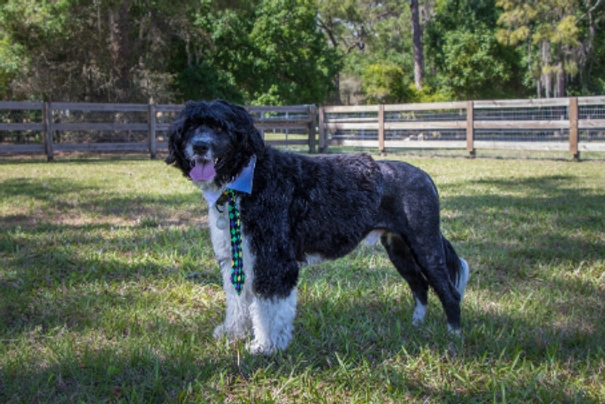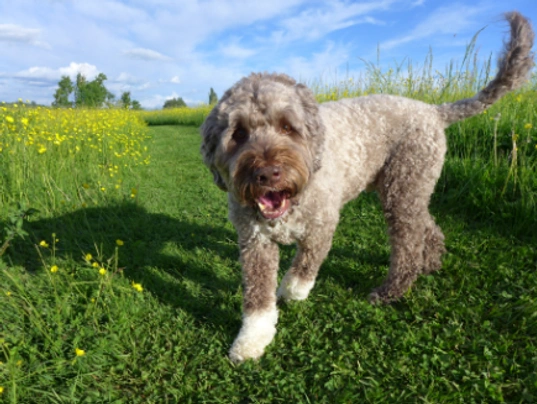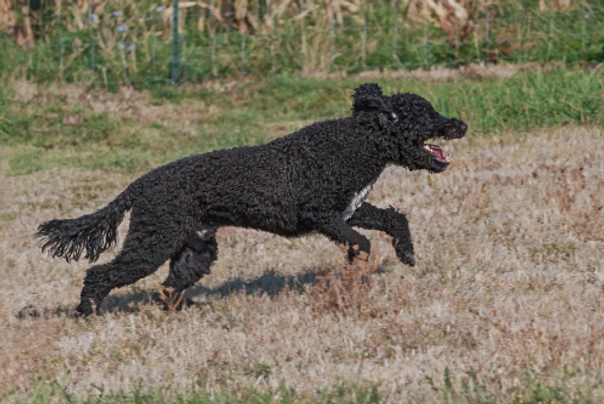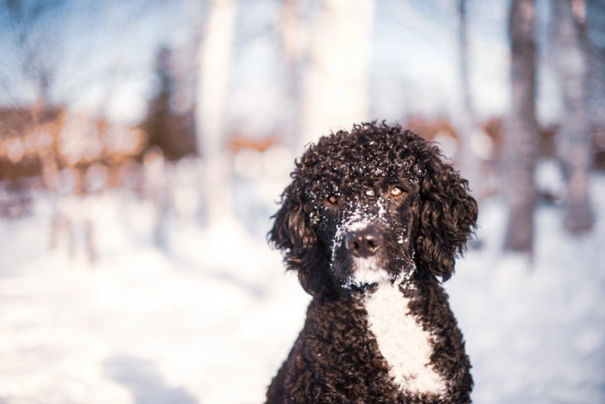Portuguese Water Dog
Pros
Cons
Introduction of the Portuguese Water Dog
The Portuguese Water Dog is a distinctive looking dog that as their name suggests loves being in and around water. They have webbed feet which means they are extremely strong swimmers. They also boast having non-shedding coats with their hindquarters and tails being clipped short which adds to their unusual and charming looks. Although a relative newcomer to the UK the Portuguese Water Dog is still a very popular choice in Portugal more especially with fishermen although they are renowned for being good companions and family pets too.
History of the Portuguese Water Dog
It's thought the Portuguese Water Dog was first introduced to Portugal by Moor traders and that they share an ancestry with other water dogs found in Europe at that time in history. They became a firm favourite with Portuguese fishermen thanks the breeds’ love of water and the fact they could retrieve lost nets. They were also prized as hunting and guarding dogs on land which led to these charming dogs being high in demand.
However it was only in the 11th century that the Portuguese Water Dog was first written about by monks who described how a dog had saved drowning man from a ship wreck. The actual origins of the breed remain a bit of a mystery but it is thought they are descendants of the same type of working and herding dog as the Poodle Puli as well as the Kerry Blue Terrier. There are those who believe the breed’s ancestors hailed from far flung Asian countries of the world too.
By the late 1800's King Carlos I became an enthusiast of the breed and through him the popularity of the PWD soared. By the 1930's a wealthy Portuguese Shipping Heir one Vasco Bensaude purchased examples of these proud dogs from local fishermen and started his own breeding programme. Most Portuguese Water Dogs can trace their ancestry back to one of his dogs called "Leao".
Today the Portuguese Water Dog remains a bit of an unknown here in the UK but the breed is recognised by The Kennel Club. With this said anyone wishing to share a home with one of these extraordinary water loving dogs would need to register their interest with a breeder and be put on a waiting list because so few puppies are bred and registered with The Kennel Club every year.
Interesting facts about the breed
- Is the Portuguese Water Dog a vulnerable breed? No they are fast becoming a popular breed in the UK thanks to their kind loyal natures but anyone wanting to share a home with a PWD would need to go on a waiting list because few well-bred Kennel Club registered puppies are available every year
- As their name suggests PWDs adore being in water no matter the weather
- The breed is known by many other names which includes the Portuguese Fishing Dog
- They are exceptionally strong swimmers having webbed feet
- The breed almost vanished altogether but thanks to a fishing magnate Portuguese Water Dogs was saved during the 1930's
- President Obama owned a Portuguese Water Dog
- Anyone wanting to share a home with a Portuguese Water Dog would need to register their interest with breeders and go on a waiting list for the pleasure of doing so
- Most PWDs can trace their ancestry back to one dog named "Leao".
Appearance of the Portuguese Water Dog
Height at the withers: Males 50 - 57 cm Females 43 - 52 cm
Average weight: Males 19 - 25 kg Females 16 - 22 kg
Portuguese Water Dogs are large athletic looking dogs that boast having extremely weather resistant coats. Their hindquarters are normally clipped with just a plume of hair being left on the tips of a dog's tail. PWDs can have two types of coat with the first being long and wavy whereas the other type is that much shorter and harsher to the touch with dogs having very compact curls all over their bodies. Their heads are large yet nicely proportioned with their skulls being a little longer than a dog’s muzzle. They have a very distinct and well-defined occiput and stop with their muzzles tapering slightly to their noses.
They have a central furrow in their foreheads and nice wide noses with well open nostrils. The colour of their noses matches the colour of a dog's coat. Their eyes are round and medium in size being set well apart on a dog's face and can be either black or dark brown in colour but the rims are always dark. Their ears are heart shaped and thin drooping down and being well set above a dog's eye level and which dogs carry close to the head.
The Portuguese Water Dog has a strong jaw with a perfect scissor bite where their upper teeth neatly overlap their lower ones and they also boast having well developed canines. Their necks are straight well-muscled and short with dogs carrying them high. Front legs are straight nicely boned and muscular. Shoulders are well laid back and well-muscled.
Their bodies are nicely proportioned with dogs having wide withers and nice wide and deep chests that reach down to their elbows. Ribs are well sprung and loins short and strong with dogs having moderately tucked up bellies. Their back legs are straight and extremely well-muscled and their feet are round in shape but rather flat with toes not being too knuckled up or long. The membrane in between a dog's toes reaches to the tip and is covered with hair. Their tails are thicker at the base but taper to the tip and is moderately set. PWD's carry their tails gaily and slightly curved when they are on the move or alert.
When it comes to their coat the Portuguese Water Dog has a profuse coat that covers their entire body except on the underside of their front legs and thighs. There is no undercoat in either variety however dogs with longer coats have loose waves and a nice sheen on their coats with the hair on a dog's ear standing upright being well feathered. Dogs with shorter coats have much denser harsher and more compact curls which lack the sheen of longer coated dogs. The hair on a dog's head matches their body and the hair on their ears is slightly wavy. A dog's muzzle as well as their hindquarters from the last rib towards their tail is clipped with two thirds of their tail being clipped leaving just a plume of hair on the tip. The accepted breed colours for Kennel Club registration are as follows:
- Black
- Black & White
- Brown
- Brown & White
- White
Gait/movement
When a Portuguese Water Dog moves they do so with a lively gait taking short steps when walking. When trotting they are light on their feet and when galloping they do so energetically.
Faults
The Kennel Club frowns on any exaggerations or departures from the breed standard and would judge the faults on how much they affect a dog's overall health and wellbeing as well as their ability to perform.
Males should have both testicles fully descended into their scrotums and it is worth noting that a dog can be a little lighter or heavier as well as slightly taller or shorter than set out in the Kennel Club breed standard which is only given as a guideline**.**
Temperament of the Portuguese Water Dog
The Portuguese Water Dog is highly prized in their native Portugal for being a loyal friendly and intelligent dog that likes nothing better than to please. However they are quite independent thinkers and quite wilful thanks to a stubborn streak in them which one of the reasons they need to be handled and trained with a firm yet gentle hand. The Portuguese Water Dog needs to know their place in the pack and what an owner expects of them.
With this said they are a good choice for families because in the right hands and with the correct amount of early socialisation the Portuguese Water Dog is easy to train. They become valuable members of a household and like nothing more than to be involved in everything that goes on around them. However they are high-energy dogs and as such they do better when living with people who lead active outdoor lives and where one person usually stays at home when everyone else is out of the house so that they always have company. If left to their own devices for too long a Portuguese Water Dog might develop separation anxiety which often sees these dogs mouthing things they find around the home which is very much the "retriever" trait in them.
Because they are so intelligent a PWD needs to be given the right amount of mental stimulation every day otherwise a dog could develop some unwanted and destructive behavioural issues around the home. They thrive in a country environment because they love being outside and more especially around water. However care must be taken when walking a PWD anywhere near any dangerous watercourses just in case they decide to jump in.
Are they a good choice for first time owners?
Portuguese Water Dogs are not the best choice for first time dog owners because they need to be socialised handled and trained by people who are familiar with the specific needs of such a clever high-energy dog. They also need a tremendous amount of coat care which is another reason when they are not the best choice for novice owners**.**
What about prey drive?
Although PWDs are social by nature and love playing they have a high prey drive which means they should not be trusted around smaller animals and pets they don't already know because they could well see them as "fair game". Care should also be taken as to where and when a Portuguese Water Dog runs off the lead more especially when there is livestock and wildlife close by.
What about playfulness?
Portuguese Water Dogs are known for their fun-loving natures and they enjoy nothing more than to play interactive games with the people they love. They excel at many canine sports which includes activities like flyball and agility to name but two.
What about adaptability?
PWDs are better suited to people who have secure back gardens they can safely roam in whenever possible so they can really express themselves as they should. As such they are not the best choice for people who live in apartments bearing in mind that a Portuguese Water Dog is not only very intelligent but they are high-energy characters with a low boredom threshold.
What about separation anxiety?
Although the Portuguese Water Dog forms strong ties with their families they are not generally known to suffer from separation anxiety providing they are never left on their own for too long that is. No dog likes to be left to their own devices for longer periods of time which could see them develop some unwanted and destructive behavioural issues around the home. This is a dog's way of expressing their frustration and to relieve the stress/boredom they are feeling at being on their own for too long**.**
What about excessive barking?
Some PWDs like the sound of their own voices a little too much which is something that needs to be gently nipped in the bud when a dog is still young being careful not to frighten them. Others will only bark when there are strangers about or when something they don't like is going on in their surroundings.
Do Portuguese Water Dogs like water?
As their name suggests a PWD loves swimming and will take to the water whenever they can more especially when the weather is hot or even when it is chillier. However if anyone who owns a dog that does not like water should never force them to go in because it would just end up scaring them. With this said care should always be taken when walking a Portuguese Water Dog off the lead anywhere near more dangerous watercourses just in case a dog decides to leap in and then needs rescuing because they cannot get out of the water on their own.
Are Portuguese Water Dogs good watchdogs?
PWDs are incredibly loyal to their families and they are always on the alert which in short means they are extremely good watchdogs. However rarely would a Portuguese Water Dog show any sort of aggressive behaviour whilst going about the business of protecting an owner and their property unless they feel threatened in any way that is in which case they would stand their ground not letting anyone passed them and barking to alert an owner.
Intelligence / Trainability of the Portuguese Water Dog
Thanks to their intelligence and the fact these dogs love to please in the right hands the Portuguese Water Dog is easy to train. However as previously mentioned their training must start early it should be consistent and always fair so dogs know what is expected of them. In the right environment and with the correct amount of socialisation and training the PWD excels when it comes to learning new things which they do very quickly bearing in mind that this means they quickly learn both the good and the bad.
Portuguese Water Dogs have proved themselves to excel in many canine sports but they are also often used as therapy dogs working in hospitals hospices and schools. They are also frequently used as hearing dogs assistance dog and mobility dogs that help people with household tasks they are unable to do themselves.
Portuguese Water Dog puppies like all puppies are incredibly cute and it is all too easy to spoil them when they first arrive in a new home. However they are also very intelligent and therefore quick to learn new things both the good and the bad. As such it's important for owners to start out as they mean to go on which means that as soon as a puppy is settled they must be taught the rules and boundaries so they understand what kind of behaviour is acceptable and what is not. It also helps establish a pecking order and who is the alpha dog in a household. With this said the first commands a PWD should be taught are as follows:
- Come
- Sit
- Stay
- Heel
- Quiet
- Leave it
- Down
- Bed
Children and other
Portuguese Water Dogs love being in a home environment and they get on particularly well with children. However because they are known to "mouth" things any interaction between a PWD and the kids should be supervised by an adult to make sure things don't get out of hand which could lead to one of these fun-loving dogs mouthing a smaller child.
They are not particularly good around small pets and other animals although if a dog has grown up with a family cat in the home they generally get on well together but they would think nothing of chasing a neighour’s cat whenever the opportunity arises. They are social dogs by nature and as long as a puppy has been well socialised at an early enough age Portuguese Water Dogs usually get on well with other dogs.
Health of the Portuguese Water Dog
The average life expectancy of a Portuguese Water Dog is between 12 and 15 years when properly cared for and fed an appropriate good quality diet to suit their ages.
The PWD is known to suffer from very few hereditary health issues and are known to be healthy and robust dogs However there are a couple of health issues worth knowing about if you are planning share your home with one of these active water-loving dogs. The conditions that seem to affect the breed the most include the following:
- PRA (prcd) Progressive Retinal Atrophy - DNA test available
- Gangliosidosis (GM1) - DNA test available
- Early Onset PRA (OEPRA) - DNA test available through Optigen
- Hip dysplasia - test available and dogs should be hip scored
- Elbow dysplasia - dogs should be tested
- Cataracts
- Addison's disease
- Allergies
- Follicular dysplasia (Hair loss)
- Distichiasis
- Microphthalmia and multiple congenital ocular anomalies
- Puppy Eye Syndrome (PES)
- Persistent Pupillary membranes
- Juvenile Dilated Cardiomyopathy (JDCM)
- Gastric torsion (bloat)
What about vaccinations?
PWD puppies would have been given their initial vaccinations before being sold but it is up to their new owners to make sure they have their follow-up shots in a timely manner with the vaccination schedule for puppies being as follows:
- 10 -12 weeks old bearing in mind that a puppy would not have full protection straight away but would be fully protected 2 weeks after they have had their second vaccination
There has been a lot of discussion about the need for dogs to have boosters. As such it's best to talk to a vet before making a final decision on whether a dog should continue to have annual vaccinations which are known as boosters.
What about spaying and neutering?
A lot of vets these days recommend waiting until dogs are slightly older before spaying and neutering them which means they are more mature before undergoing the procedures. As such they advise neutering males and spaying females when they are between the ages of 6 to 9 months old and sometimes even when a dog is 12 months old.
Other vets recommend spaying and neutering dogs when they are 6 months old but never any earlier unless for medical reasons. With this said many breeds are different and it is always advisable to discuss things with a vet and then follow their advice on when a dog should be spayed or neutered.
What about obesity problems?
Some PWDS can gain weight after they have been spayed or neutered and it's important to keep an eye on a dog's waistline just in case they do. If a dog starts to put on weight it's important to adjust their daily calorie intake and to up the amount of exercise they are given. Older dogs too are more prone to gaining weight and again it's essential they be fed and exercised accordingly because obesity can shorten a dog's life by several years. The reason being that it puts a lot of extra strain on a dog's internal organs including the heart which could prove fatal.
What about allergies?
PWDs are known to be predisposed to suffering from allergies and it's important for a dog to see a vet sooner rather than later if one flares up. Allergies can be notoriously hard to clear up and finding the triggers can be challenging. With this said a vet would be able to make a dog with an allergy more comfortable while they try to find out the triggers which could include the following:
- Certain dog foods that contain high levels of grains and other cereal type fillers
- Airborne pollens
- Dust mites
- Environment
- Flea and tick bites
- Chemicals found in everyday household cleaning products
Participating in health schemes
All responsible Portuguese Water Dog breeders would ensure that their stud dogs are tested for known hereditary and congenital health issues known to affect the breed by using the following schemes:
- DNA test - prcd-PRA
- DNA test for Gangliosidosis (GM1)
- DNA test for Early Onset PRA (OEPRA) through Optigen
- DNA test for Improper Coat (IC) & Curly through Optigen
What about breed specific breeding restrictions?
Apart from the standard breeding restrictions for all Kennel Club registered breeds there are no other breed specific breeding restrictions in place for the Portuguese Water Dog.
What about Assured Breeder Requirements?
For the moment there are no DNA tests or BVA screening schemes available for the Portuguese Water Dog under the Assured Breeder Scheme. However all breeders should have their dogs tested using the following:
Caring for the Portuguese Water Dog
As with any other breed PWDs need to be groomed on a regular basis to make sure their coats and skin are kept in top condition. They also need to be given regular daily exercise to ensure they remain fit and healthy. On top of this dogs need to be fed good quality food that meets all their nutritional needs throughout their lives.
Caring for a Portuguese Water Dog puppy
PWD puppies are boisterous and full of life which means it's essential for homes and gardens to be puppy-proofed well in advance of their arrival. A responsible breeder would have well socialised their puppies which always leads to more outgoing confident and friendly dogs right from the word go. With this said any puppy is going to feel vulnerable when they leave their mother and littermates which must be taken into account. The longer a puppy can remain with their mother the better although it should never be for too long either.
It's best to pick a puppy up when people are going to be around for the first week or so which is the time needed for a puppy to settle in. Puppy-proofing the home and garden means putting away any tools and other implements that a boisterous puppy might injure themselves on. Electric wires and cables must be put out of their reach because puppies love chewing on things. Toxic plants should be removed from flowerbeds and the home too.
Puppies need to sleep a lot to grow and develop as they should which means setting up a quiet area that's not too out of the way means they can retreat to it when they want to nap and it's important not to disturb them when they are sleeping. It's also a good idea to keep "playtime" nice and calm inside the house and to have a more active "playtime" outside in the garden which means puppies quickly learn to be less boisterous when they are inside.
The documentation a breeder provides for a puppy must have all the details of their worming date and the product used as well as the information relating to their microchip. It is essential for puppies to be wormed again keeping to a schedule which is as follows:
- Puppies should be wormed at 6 months old
- They need to be wormed again when they are 8 months old
- Puppies should be wormed when they are 10 months old
- They need to be wormed when they are 12 months old
Things you'll need for your puppy
There are certain items that new owners need to already have in the home prior to bringing a new puppy home. It's often a good idea to restrict how much space a puppy plays in more especially when you can't keep an eye on what they get up to bearing in mind that puppies are often quite boisterous which means investing in puppy gates or a large enough playpen that allows a puppy the room to express themselves while keeping them safe too. The items needed are therefore as follows:
- Good quality puppy or baby gates to fit on doors
- A good well-made playpen that's large enough for a puppy to play in so they can really express themselves as puppies like to do
- Lots of well-made toys which must include good quality chews suitable for puppies to gnaw on bearing in mind that a puppy will start teething anything from when they are 3 to 8 months old
- Good quality feed and water bowls which ideally should be ceramic rather than plastic or metal
- A grooming glove
- A slicker brush or soft bristle brush
- Dog specific toothpaste and a toothbrush
- Scissors with rounded ends
- Nail clippers
- Puppy shampoo and conditioner which must be specifically formulated for use on dogs
- A well-made dog collar or harness
- A couple of strong dog leads
- A well-made dog bed that's not too small or too big
- A well-made dog crate for use in the car and in the home that's large enough for a puppy to move around in
- Baby blankets to put in your puppy's crate and in their beds for when they want to nap or go to sleep at night
Keeping the noise down
All puppies are sensitive to noise including Portuguese Water Dog puppies. It's important to keep the noise levels down when a new puppy arrives in the home. TVs and music should not be played too loud which could end up stressing a small puppy out and which could end up making them more timid and shy by nature.
Keeping vet appointments
As previously mentioned PWD puppies would have been given their first vaccinations by the breeders but they must have their follow up shots which is up to their new owners to organise. The vaccination schedule for puppies is as follows:
- 10 -12 weeks old bearing in mind that a puppy would not have full protection straight away but would only be fully protected 2 weeks after they have had their second vaccination
When it comes to boosters it's best to discuss these with a vet because there is a lot of debate about whether a dog really needs them after a certain time. However if a dog ever needed to go into kennels their vaccinations would need to be fully up to date.
What about older Portuguese Water Dogs when they reach their senior years?
Older PWDs need lots of special care because as they reach their golden years they are more at risk of developing certain health concerns. Physically a dog's muzzle may start to go grey but there will be other noticeable changes too which includes the following:
- Coats become coarser
- A loss of muscle tone
- PWDs can either become overweight or underweight
- They have reduced strength and stamina
- Older dogs have difficulty regulating their body temperature
- They often develop arthritis
- Immune systems do not work as efficiently as they once did which means dogs are more susceptible to infections
Older dogs change mentally too which means their response time tends to be slower as such they develop the following:
- They respond less to external stimuli due to impaired vision or hearing
- They tend to be a little pickier about their food
- They have a lower pain threshold
- Become intolerant of any change
- Often an older dog can feel disorientated
Living with a Portuguese Water Dog in their golden years means taking on a few more responsibilities but these are easily managed and should include taking a look at their diet the amount of exercise they are given how often their dog beds need changing and keeping an eye on the condition of their teeth.
Older PWDs need to be fed a good quality diet that meets their needs at this stage of their lives all the while keeping a close eye on a dog's weight. A rough feeding guide for older dogs is as follows bearing in mind they should be fed highly digestible food that does not contain any additives:
- Protein content should be anything from 14 – 21%
- Fat content should be less than 10%
- Fibre content should be less than 4%
- Calcium content should be 0.5 – 0.8%
- Phosphorous content should be 0.4 – 0.7%
- Sodium content should be 0.2 – 0.4%
Older PWDS don't need to be given the same amount of daily exercise as a younger dog but they still need the right amount of physical activity to maintain muscle tone and to prevent a dog from putting on too much weight. All dogs need access to fresh clean water and this is especially true of older dogs when they reach their golden years because they are more at risk of developing kidney disorders.
Grooming of the Portuguese Water Dog
The Portuguese Water Dog boasts having a single but extremely thick and water-resistant coat that can be harsh with very tight curls or moderately long with much looser curls. A dog's hindquarters are usually clipped which is often referred to as a "lion clip" because all that's left on a dog's tail is a plume of hair on the tip. This task is best left up to an expert dog groomer and it would need to be done a few times a year to keep things tidy and which also means that a dog's grooming needs are kept to a minimal in between visits to the grooming parlour.
They are high maintenance on the grooming front because their coats need a daily brush even though they are non-shedding dogs which is the only way of preventing matts and/or tangles from forming which is particularly true of longer coated dogs. As such a daily brush is necessary and it helps reinforce a bond between an owner and their dog. It's also important to check a dog's ears on a regular basis especially as they love to be in water and to clean them when necessary. If too much wax builds up in a dog's ears it can lead to a painful infection which can be hard to clear up. The same can be said if too much moisture gets into a dog's ear canal so if a dog has been in the water it's really important to make sure their ears are thoroughly dried afterwards. In short prevention is often easier than cure when it comes to ear infections.
Exercise of the Portuguese Water Dog
The Portuguese Water Dog is a high energy intelligent dog and as such they need to be given the right amount of daily exercise combined with as much stimulation as possible for them to be truly happy well-rounded and obedient dogs. Ideally they need to be given at least 2 hour’s exercise a day and as much mental stimulation as possible which should include lots of interactive games.
A shorter walk in the morning would be fine but a longer more interesting one in the afternoon is a must. These dogs also like to be able to roam around a back garden as often as possible so they can really let off steam. However the fencing must be extremely secure to keep these energetic dogs in because if they find a weakness in the fence they will soon escape out and get into all sorts of trouble.
With this said PWD puppies should not be over exercised because their joints and bones are still growing. This includes not letting a dog jump up and down from furniture or going up or down the stairs. Too much pressure placed on their joints and spines at an early age could result in a dog developing problems later in their lives.
Feeding of the Portuguese Water Dog
If you get a PWD puppy from a breeder they would give you a feeding schedule and it's important to stick to the same routine feeding the same puppy food to avoid any tummy upsets. You can change a puppy's diet but this needs to be done very gradually always making sure they don't develop any digestive upsets and if they do it's best to put them back on their original diet and to discuss things with the vet before attempting to change it again.
Older dogs are not known to be fussy or finicky eaters but this does not mean you can feed them a lower quality diet. It's best to feed a mature dog twice a day once in the morning and then again in the evening making sure it's good quality food that meets all their nutritional requirements. It's also important that dogs be given the right amount of exercise so they burn off any excess calories or they might gain too much weight which can lead to all sorts of health issues. Obesity can shorten a dog's life by several years so it's important to keep an eye on their waistline from the word go.
Because Portuguese Water Dogs are prone to suffer from bloat it is important that they be fed twice a day instead of giving them just one larger meal a day. It's also a good idea to invest in a stand to place their feed bowl which makes it easier for these large dogs to eat comfortably without having to stretch their necks down low to reach their food. You should never exercise a dog just before or just after they have eaten either because this puts them more at risk of suffering from gastric torsion (bloat) which as previously mentioned can prove fatal if not treated as a matter urgency.
Feeding guide for a Portuguese Water Dog puppy
Puppies need to be fed a highly nutritious good quality diet for them to develop and grow as they should. As a rough guide a PWD puppy can be fed the following amounts every day making sure their meals are evenly spread out throughout the day and it's best to feed them 3 or 4 times a day:
- 2 months old - 191g to 238g depending on puppy's build
- 3 months old - 223g to 292g depending on puppy's build
- 4 months old - 239g to 318g depending on puppy's build
- 5 months old - 243g to 339g depending on puppy's build
- 6 months old - 243g to 361g depending on puppy's build
- 8 months old - 211g to 325g depending on puppy's build
- 10 months old - 177g to 261g depending on puppy's build
Once a puppy is 13 months old they can be fed adult dog food.
Feeding guide for an adult Portuguese Water Dog
Once fully mature an adult Portuguese Water Dog must be fed a good quality diet to ensure their continued good health. As a rough guide an adult PWD can be fed the following amounts every day:
- Dogs weighing 16 kg can be fed 197g to 259g depending on activity
- Dogs weighing 19 kg can be fed 225g to 283g depending on activity
- Dogs weighing 22 kg can be fed 250g to 329g depending on activity
- Dogs weighing 25 kg can be fed 275g to 362g depending on activity
Portuguese Water Dog price
If you are looking to buy a Portuguese Water Dog you may have to go on a breeder's waiting list because so few puppies are bred and registered with The Kennel Club every year. You would need to pay anything upwards of £1000 for a well-bred pedigree puppy. The cost of insuring a male 3-year-old PWD in northern England would be £28.32 a month for basic cover but for a lifetime policy this would set you back £63.49 a month (quote as of October 2018). When insurance companies calculate a pet's premium they factor in several things which includes where you live in the UK a dog's age and whether they have been neutered or spayed among other things.
When it comes to food costs you need to buy the best quality food whether wet or dry to feed your dog making sure it suits the different stages of their lives. This would set you back between £40 - £50 a month. On top of this you would need to factor in veterinary costs if you want to share your home with a PWD and this includes their initial vaccinations their annual boosters the cost of neutering or spaying a dog when the time is right and their yearly health checks all of which quickly adds up to over £1200 a year.
As a rough guide the average cost to keep and care for a Portuguese Water Dog would be between £80 to £120 a month depending on the level of insurance cover you opt to buy for your dog but this does not include the initial cost of buying a well-bred healthy Kennel Club registered pedigree Portuguese Water Dog puppy.
Buying advice
When visiting and buying any puppy or dog there are many important things to consider and questions to ask of the breeder/seller. You can read our generic puppy/dog advice here which includes making sure you see the puppy with its mother and to verify that the dog has been wormed and microchipped.
PWDs have fast become a popular choice when it comes to family pets both in the UK and elsewhere in the world which means that healthy well-bred KC puppies can often command lots of money. As such with PWDs there is specific advice questions and protocols to follow when buying a puppy which are as follows:
- There are many online and other adverts showing images of adorable Portuguese Water Dog puppies for sale. However the sellers ask buyers for money up front before agreeing to deliver a puppy to a new home. Potential buyers should never buy a PWD puppy unseen and should never pay a deposit to a seller before collecting a puppy from them
- As previously touched upon Portuguese Water Dogs are fast finding a big fanbase in the UK. As such there are many amateur breeders/people who breed from a dam far too often so they can make a quick profit without caring for the welfare of the puppies their dam or the breed in general. Under Kennel Club rules a dam can only produce 4 litters and she must be between a certain age to do so. Anyone wishing to buy a PWD puppy should think very carefully about who they purchase their puppy from and should always ask to see the relevant paperwork pertaining to a puppy's lineage their vaccinations and their microchipping
- Prospective owners should be very careful when considering buying a PWD from abroad and to make sure parent dogs and puppies have been given all the relevant tests for hereditary conditions known to affect the breed
- Prospective owners should always make sure that parent dogs of a puppy they are considering buying have "correct" coats and that they have been tested for Incorrect Coat (IC) before committing to buying them

Portuguese Water Dog Puppies – Born 2nd of July 25
£2,500
Portuguese Water Dog puppies for sale
£2,200
